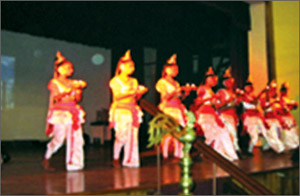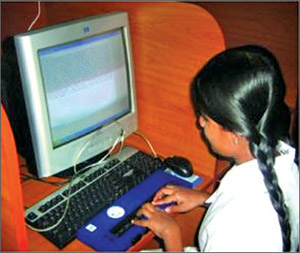Hundred years of selfless service
Nimal BHARETI
The Ceylon School for the Blind comprising of three schools, the
School for the Blind and the School for the Deaf Ratmalana, and Nuffield
School for the Deaf and Blind Kaithady Jaffna, celebrates one hundred
years of selfless service to the deaf and blind this year. A series of
events have been planned to commemorate this historic event.
The celebrations commenced with a Centenary Walk held in February
where a large number including the Bishop of Colombo participated and a
well attended Variety Entertainment “Siyawasaka Ridmaya” held at Ladies
College. The main centenary celebrations will be held on June 17 at the
schools premises Ratmalana with a series of events starting with a
Service of Thanksgiving at 8 am. followed by the issue of a special
commemoration stamp and an educational, arts, and crafts exhibition by
the students.
 The School for the Deaf and Blind initially started as one school,
was founded by Mary Chapman, a missionary lady belonging to the Church
of England Zenana Missionary Society (CEZMS). The School for the Deaf and Blind initially started as one school,
was founded by Mary Chapman, a missionary lady belonging to the Church
of England Zenana Missionary Society (CEZMS).
In response to her appeal for funds, many well wishers gave donations
generously – worthy of mention is the gift of A.J.R. de Soysa who,
within hours of the appeal, offered a free site of six acres at
Kandawala where the School for the Blind is presently located.
Chapman rented a small building at Dehiwala and started the school in
1912 with just four children; by 1913, it increased to 18 deaf and 6
blind children. In July1914 the school shifted to Ratmalana. In 1926 an
additional four acres of land adjoining the existing land where the Deaf
School is now located was given to the school by Abdul Caffoor.
In 1933 the CEZMS, which hitherto managed the school, decided to hand
over the management of the school to the Diocese of Colombo. A Board of
Governors, later named the Board of Trustees, with the Bishop as
Chairperson, was appointed to manage the school. In 1945 with the
permission of the Education Department the Ratmalana School was divided
into two and named as the School for the Deaf and School for the Blind.
The school at Kaithady Jaffna in the Tamil medium started initially
with a generous gift from Viscount Nuffield, and just 18 students ; it
expanded quite rapidly. During the war, the school had to be evacuated
to St. John’s College. With temporary restoration of peace in 2003,
extensive repairs were carried out to school buildings with aid from
international aid agencies and the school was able to move back to
Kaithadi towards the end of 2004. Since the war ended in in 2009, the
school has been operating successfully.
All three schools provide 600 students with an education, which
follows the syllabus used in government schools. In addition food and
lodging, healthcare, recreational facilities, and vocational training
are provided free of charge. Though managed by the Diocese of Colombo,
the students are mostly non-Christian and all facilities are given to
them for their religious activities.
 The students are taught up to the GCE ‘O’ Level ; while deaf students
find it difficult to pass the O Level exams, many in the School for the
Blind succeed at the ‘O’ Levels, and they proceed to mainstream schools
to do their ‘A’ Levels. Some of them have entered universities and well
over one hundred have obtained their degrees. There have also been a few
who have become lawyers and have found work in various areas. The students are taught up to the GCE ‘O’ Level ; while deaf students
find it difficult to pass the O Level exams, many in the School for the
Blind succeed at the ‘O’ Levels, and they proceed to mainstream schools
to do their ‘A’ Levels. Some of them have entered universities and well
over one hundred have obtained their degrees. There have also been a few
who have become lawyers and have found work in various areas.
At The School for the Blind nearly 70% of the students are partially
sighted and have benefitted from computer assisted classroom teaching
and multi-media techniques. The library is equipped with vision
enhancing equipment while the totally blind have to rely on Braille
alone. A Braille printing section has been established, to enable school
text- books and other books to be translated to Braille.
In the School for the Deaf classroom teaching employs both sign
language and lip reading. While sign language is effective for
communication within the deaf community, it has been found to isolate
the hearing -impaired.
The school has now introduced Computer Assisted Classroom Teaching
and Multimedia techniques.
Vocational training which traditionally included training in fields
such as pottery, weaving, basket weaving, sewing, carpentry, printing,
hair dressing, and other handicrafts like patchwork, card making,
vegetable carving, etc needs to be updated and include more job oriented
skills such as tailoring, computer graphics, modern printing and
catering etc. The school cordially invites the public and private sector
participants and stake -holders to help them develop such courses.
Like in any other school, sports such as cricket and athletics and
other extra-curricular activities are given much emphasis. While
inter-house sports activities take place, the children also participate
in competitions at zonal, provincial, and national level. Students have
even been sent abroad for sports competitions.
Drama and music are very much encouraged. The School for the Blind
Ratmalana and the Blind unit at Kaithady have western and oriental
school bands. Music is taught to the students and the students of the
Blind School at Ratmalana have even won prizes in Western music and
singing competitions. The students are also taught dancing and drama and
dance troupes have been formed in both the Deaf and Blind schools. The
blind students at Ratmalana and Kaithady have produced and have had
public drama performances.. Cubs, Scouts, Little Friends & Guides are
very active and participate in rallies at provincial and national levels
and give the opportunity for students to interact with others and engage
in community service projects as with mainstream
We can justifiably be proud of the fact that today there are many
schools in the island, modeled on the Ratmalana and Kaithady schools.
The deaf and blind are no longer called ‘disabled’ but ‘differently
abled’ as they have demonstrated that being handicapped and impaired
visually or through hearing deficiencies is no barrier to their
development as they have shown their capabilities and talents in
different ways.
|



